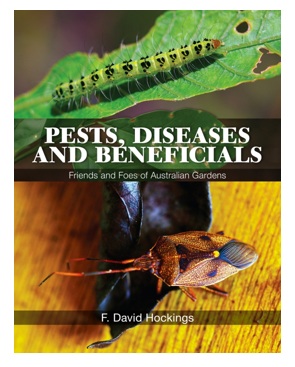
BOOK REVIEW
PESTS, DISEASES AND BENEFICIALS – Friends and Foes of Australian Gardens is a book for the real bug enthusiast. Not really a coffee table book, unless you enjoy a few grubs, mites and spiders with your coffee, it’s more of a reference book for the home gardening library.
The content is set out with the first few chapters explaining the classification of pests and diseases as they fit into the plant and animal kingdom. This section also discusses the distinction between friend and foe in the garden and explains how predators work to carry out natural control of unwanted effects. Being a CSIRO publication, you would expect some depth to this classification and you will not be disappointed. It goes into some detail about the mouthparts of each creature, showing how different damage occurs on the plant. This is good material for the budding student or the very keen garden bug enthusiast (although the author would rightfully correct us on the true definition of “bug”).
The photography is the book’s strength. The colour photos or “illustrations” in the second section of the book are detailed and extensive, making them great for identification. They are close up shots of pests and diseases that many gardeners wouldn’t normally see on plants without a good hand lens. It also makes identification of beneficial predators much easier for the average gardener. This is what makes the book worthwhile.
While the book is set out to identify pests & diseases based on what parts of the plant are affected, I found the book did lose some flow for the gardener wanting to know how to deal with a specific pest or disease. It requires the reader to flick between sections to determine exactly what was appropriate control for specific problems.

The book gives instructions on dealing with pests and diseases, yet there was some reliance on pesticides rather than taking a fully organic approach for control. It was, nevertheless, encouraging to see statements like this:
“It is pointless spraying or dusting with pesticide unless you know what pest you are dealing with, and it is essential to know if treatment is even necessary. It should be understood that not all of the small animals that can be found in gardens are pests. Many of them are harmless or beneficial in a variety of ways.” (pg. 2)
and this:
“Pesicides should be applied only if they are really necessary. Plants have evolved with some pests and there is evidence that suggests that small numbers of pests may even stimulate plant growth. No plant or garden is better for having a pesticide applied if there is no need for it. Be prepared for the unexpected. Sometimes insecticides can damage the plants you are tryinig to protect.” (pg. 31)
Despite there being appropriate warnings for the overuse and incorrect use of too many pesticides, the main downfall with the book is that it does not detail what the reader can do to attract the natural predators into the garden.
The author introduced the book as a revision of the original Friends & Foes of Australian Gardens (1980) based on the need to keep up with changes in the registration and use of pesticides since it’s first publication. It is disappointing that the new and revised edition does not include reference to some of the safer certified organic pesticides now available on the market today, instead, the control chart in the appendix seemed to promote only Yates pesticide products.
Would I include the book as a reference for my home library? ….. Definitely, despite the book’s limitations, the illustrations are a valuable tool for identification of friends and foes, so you can better decide what you allow to occupy your garden.
PESTS, DISEASES AND BENEFICIALS – Friends and Foes of Australian Gardens.
David Hockings AM, March 2014, CSIRO publishing.
Paperback, 280 pages. RRP $39.95




 Twitter
Twitter Facebook
Facebook
Great review. It is a bit sad that it does not refer to organic and friendlier products, ESP from CSIRO. Though perhaps this is how the book’s research was funded?
There is a need for real restraint when using garden pesticides – my neighbour uses poison instead of getting down on his hands and knees and removing weeds…
Hi love what you are achieving here – using poison around the home for us is lessened by having our chickens and letting spiders etc do their work in killing pests.
thanks